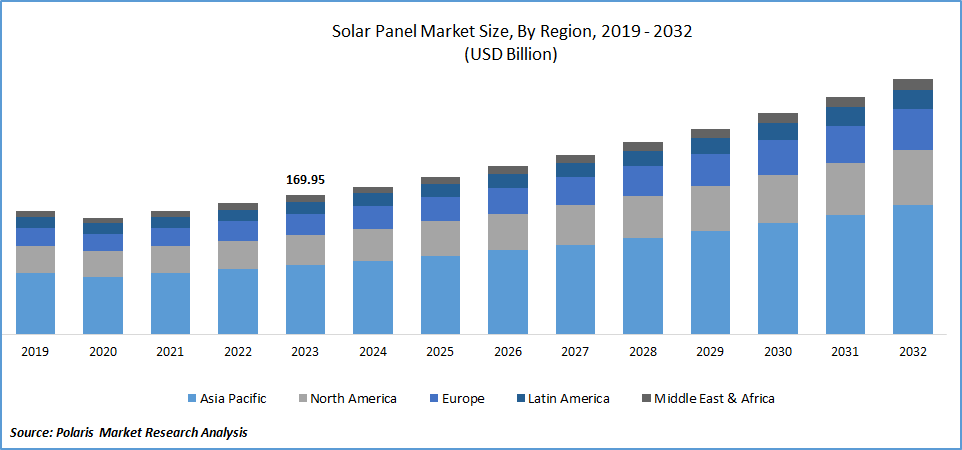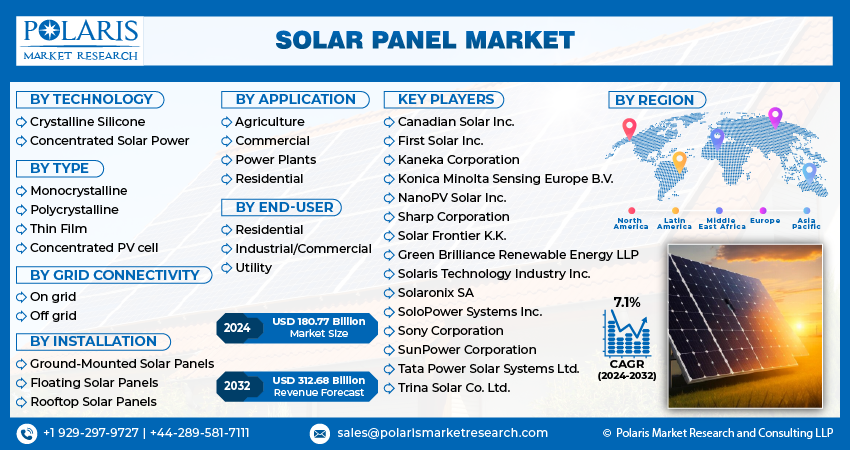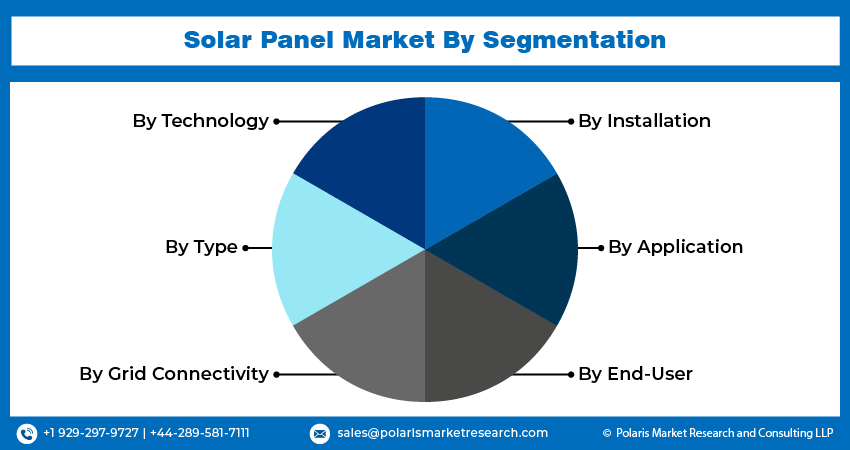
Solar Panels Market Share, Size, Trends, Industry Analysis Report, By Technology; By Type; By Grid Connectivity; By Installation; By Application; By End User; By Region; Segment Forecast, 2024 – 2032
- Published Date:Apr-2024
- Pages: 118
- Format: PDF
- Report ID: PM1538
- Base Year: 2023
- Historical Data: 2019-2022
Report Outlook
Solar panels market size was valued at USD 169.95 billion in 2023. The market is anticipated to grow from USD 180.77 billion in 2024 to USD 312.68 billion by 2032, exhibiting a CAGR of 7.1% during the forecast period.
Solar Panels Market Overview
The solar panels market refers to the industry involved in the manufacturing, distribution, and installation of photovoltaic modules designed to convert sunlight into electricity. This market encompasses a range of technologies and applications aimed at harnessing solar energy for residential, commercial, and industrial use. The growing consumer energy demand and a surge in the number of people switching towards renewable energy sources have raised the demand for solar panels in the home rooftop solar industry. This rise is being fueled by the declining cost of producing solar cells utilizing materials like polysilicon and silver.

To Understand More About this Research:Request a Free Sample Report
Businesses in this sector are focusing on creating new technologies with enhanced production techniques and capacities to lower their operating expenses and carbon footprint, which is expected to spur market expansion in the near future. Solar panel market advancement will further be fueled by the numerous governments worldwide that are implementing policies and providing incentives to promote the use of solar panels. For instance, In February 2024, the Delhi government, under the Delhi Solar Policy 2024, aimed to accurately analyze sunlight patterns using satellite imagery to calculate the power generation potential of rooftops. This policy encourages residents to install solar panels by offering generation-based incentives, capital subsidies, and the opportunity to sell excess electricity.
Thin-film solar panels are anticipated to contribute to maximizing sales as they are energy-efficient for a wide range of residential and industrial applications, including consumer electronics, military, and space. These panels are widely used to generate power, especially in locations where conventional solar cells are impractical. The need for highly flexible and eco-friendly products has also risen as a key consequence of establishing several regulations and strict energy norms that have positively influenced the global market.
The coronavirus pandemic outbreak hit the sector hard because most firms were small-sized with dependency on imports for solar cells and modules.
Solar Panels Market Dynamics
Market Drivers
Rising Need for Renewable Energy Sources is Creating Demand in the Market
Demand for renewable energy is rising as natural resources continue to deplete, causing damaging effects on the environment. Individuals are adopting sustainable energy solutions – solar panels are an appealing alternative due to their numerous benefits over conventional energy sources. Additionally, the increase in the installation of solar systems, specifically the ongoing decline in the costs of solar cell modules, rapid urbanization, and augmented consumer spending, has affected market growth positively. It is anticipated that the demand for solar panels will continue to rise as a result of these benefits, especially in regions with a high concentration of water bodies.
Rising Investments in the Renewable Energy Sector Notably Drive Market Growth
Renewable energy has seen a rise in global investments due to its decreased carbon emissions and relatively affordable manufacturing prices. The industry is expected to grow and innovate, raising production capacity, cutting costs, and boosting product efficiency as more investors pour money into the development and manufacturing of solar panels. As a result, customers can access and afford solar energy, which is propelling the expansion of the solar panel market.
Market Restraints
The Cost of Manufacturing and Installing Solar Panels Remains Relatively High
Solar panel installation has a high cost, which acts as the main limiting factor in the global market for solar panels. For the purpose of installing the panels, a specific quantity of land must be set aside. This requirement for land is directly proportional to the energy. Some consumers may find it difficult to justify the initial outlay necessary to convert to solar power. After the panels are installed, the area cannot be used for any other purpose, which limits the growth of the solar panel. Improvement in the efficiency of solar panels will lead to better efficiency and cost-effectiveness.

Report Segmentation
The market is primarily segmented based on technology, type, grid connectivity, installation, application, end-user, and region.
|
By Technology |
By Type |
By Grid Connectivity |
By Installation |
By Application |
By End-User |
By Region |
|
|
On grid Off grid |
|
|
|
|
To Understand the Scope of this Report:Speak to Analyst
Solar Panels Market Segmental Analysis
By Technology Analysis
- The crystalline silicon segment has dominated the solar panel market for years and is anticipated to lead the industry over the forecast period from 2024 to 2032. This segment has seen significant growth due to ongoing technological advancements in solar PV. Its high efficiency, reliability, long-term performance, and reduced manufacturing costs drive the solar panel market growth. Silicon is easily available in abundance and at a relatively cheaper rate.
- The concentrated solar power technology segment is anticipated to grow due to its capability of storing heat energy that can be utilized in the absence of sunlight, overcoming the limitation of solar power's intermittent nature. This technology directly aims at converting solar radiation into electricity, but it is yet to be adopted to its full potential due to cost concerns.
By Type Analysis
- The polycrystalline panels, referred to as the ‘multicrystalline panels’ segment, dominated the solar panels market. They are well accepted due to their less complicated production process with minimal waste and use of lower-quality silicon, which makes them an affordable solution. However, they require slightly more space to produce the same amount of energy.
- The concentrated PV (Photovoltaic) cells segment is projected to grow at the fastest CAGR due to its low cost of energy. Low-cost production is due to less requirement of PV material during manufacturing. Formation of hot spots is possible with concentrated sunlight, produced by using inexpensive concentrating optics.
By Grid Connectivity Analysis
- On grid connectivity type has dominated the solar panels market and is expecting higher revenue growth. It is easy to maintain due to the absence of batteries in the on-grid system, which eliminates the need for the user to purchase a costly battery backup to store extra energy and significantly saves on power bills.
- The off-grid connectivity type is anticipated to experience significant growth in the coming years, driven by the growing demand for solar panels in residential, industrial, and commercial settings due to increased awareness. These have smaller market shares due to their limited applications and higher costs for energy storage systems but hold the potential to expand.
By Installation Analysis
- The ground-mounted solar panels segment dominated the solar panels market due to their ability to yield greater energy production per panel. They act as an alternative to traditional rooftop installations. They offer easy placement and customization of angle and orientation to optimize solar energy harvesting.
- The rooftop solar panel segment is projected to grow at the fastest CAGR. The adoption rate of solar rooftop panels is accelerating as they offer cost savings. Calculating the price of electricity generated by solar rooftops is easy. The government offers tax credits to those who install rooftop solar panels to aid in reducing their carbon footprint. For instance, in June 2024, the federal solar tax credit, known as the solar investment tax credit (ITC), offers homeowners a substantial incentive to invest in solar power systems in U.S. Currently, eligible individuals can claim 30% of their total solar PV system costs as a tax credit, encouraging widespread adoption of renewable energy solutions.
By Application Analysis
- The commercial segment has dominated the market share due to its cost savings, environmental preservation, and sustainability benefits. Technological advancements and increasing investments in renewable energy are driving the growth of the commercial segment, making it an attractive choice for businesses.
- The residential segment is anticipated to grow significantly as residential buildings are adopting rooftop solar PV systems with energy storage systems, which is driving up demand in the market. An increase in population and urbanization will lead to increasing energy demands.
By End-User Analysis
- Industrial/commercial segment has dominated the market share due to its cost savings, environmental preservation, and sustainability benefits. Technological advancements and increasing investments in renewable energy are driving the growth of the commercial segment, making it an attractive choice for businesses.
- The residential segment is anticipated to grow significantly as residential buildings adopt rooftop solar PV systems with energy storage systems, driving up demand in the market. The increase in population and urbanization will also lead to increasing energy demands.

Regional Analysis
- Asia Pacific region led the global market and is predicted to continue leading it over the projected time. The expanding use of solar PV modules in numerous utility-scale, residential, and commercial applications, coupled with the surge in infrastructure development and rising investments for the extension of manufacturing capabilities throughout the region, are the main factors contributing to the segment market's growth. For instance, in March 2024, China accounted for a major share of global solar panel manufacturing, and the remaining are also located in Asia, including Vietnam, Malaysia, and India. China's manufacturing capacity for solar was more than double the global demand in 2023.
- Europe region is anticipated to develop at the quickest rate with a strong CAGR during the forecast period. The region’s robust growth is due to the increasing consumer demand for clean energy and rising energy efficiency along with the increased emphasis on reducing greenhouse gas emissions by implementing solar energy as the best alternative to traditional energy sources supplying the region's electricity demands.

Competitive Landscape
Major market players are undertaking different initiatives to enhance their market developments along with strategic collaborations. They are spending a lot on R&D to increase their product lines, which will help the solar panel industry grow even more. Worldwide footprint, including new product launches, contractual agreements, mergers and acquisitions, increased investments, market developments and collaboration with other organizations drives the solar panel market. Upcoming players in the industry must offer cost-effective items to expand and survive in an increasingly competitive and rising market.
Some of the major players operating in the global market include
- Canadian Solar Inc.
- First Solar Inc.
- Green Brilliance Renewable Energy LLP
- Kaneka Corporation
- Konica Minolta Sensing Europe B.V.
- NanoPV Solar Inc.
- Sharp Corporation
- Solar Frontier K.K.
- Solaris Technology Industry Inc.
- Solaronix SA
- SoloPower Systems Inc.
- Sony Corporation
- SunPower Corporation
- Tata Power Solar Systems Ltd.
- Trina Solar Co. Ltd.
Recent Developments
- In March 2024, KEREA and GOGLA collaborated to harness the income-generating potential of solar over the next four years, bringing modern, clean energy benefits to a larger portion of the Kenyan population.
- In February 2024, Tesla, along with a selected partner, is aiming to harness solar energy to light up 1 Cr Indian households by providing 300 units of free electricity.
- In July 2023, India experienced rapid growth and is on the fast track to becoming a significant player in the global solar industry by achieving self-sufficiency in solar modules by 2026.
Report Coverage
The solar panels market report emphasizes on key regions across the globe to provide a better understanding of the product to the users. Also, the report provides market insights into recent developments and trends and analyzes the technologies that are gaining traction around the globe. Furthermore, the report covers an in-depth qualitative analysis pertaining to various paradigm shifts associated with the transformation of these solutions.
The report provides a detailed analysis of the market while focusing on various key aspects such as competitive analysis, technology, type, connectivity grid, installation, application, end-user, and their futuristic growth opportunities.
Solar Panels Market Report Scope
|
Report Attributes |
Details |
|
Market size value in 2024 |
USD 180.77 billion |
|
Revenue forecast in 2032 |
USD 312.68 billion |
|
CAGR |
7.1% from 2024 – 2032 |
|
Base year |
2023 |
|
Historical data |
2019 – 2022 |
|
Forecast period |
2024 – 2032 |
|
Quantitative units |
Revenue in USD billion and CAGR from 2024 to 2032 |
|
Segments covered |
By Technology, By Type, By Connectivity grid, By Installation, By Application, By End-user, By Region |
|
Regional scope |
North America, Europe, Asia Pacific, Latin America, Middle East & Africa |
|
Customization |
Report customization as per your requirements with respect to countries, region, and segmentation. |
FAQ's
Solar Panels Market report covering key segments are technology, type, grid connectivity, installation, application, end-user, and region.
Solar Panels Market Size Worth $ 312.68 Billion By 2032.
Solar Panels Market exhibiting the CAGR of 7.1% during the forecast period
Asia Pacific is leading the global market
The key driving factors in Solar Panels Market rising demand for renewable energy sources creating demand in the market.
